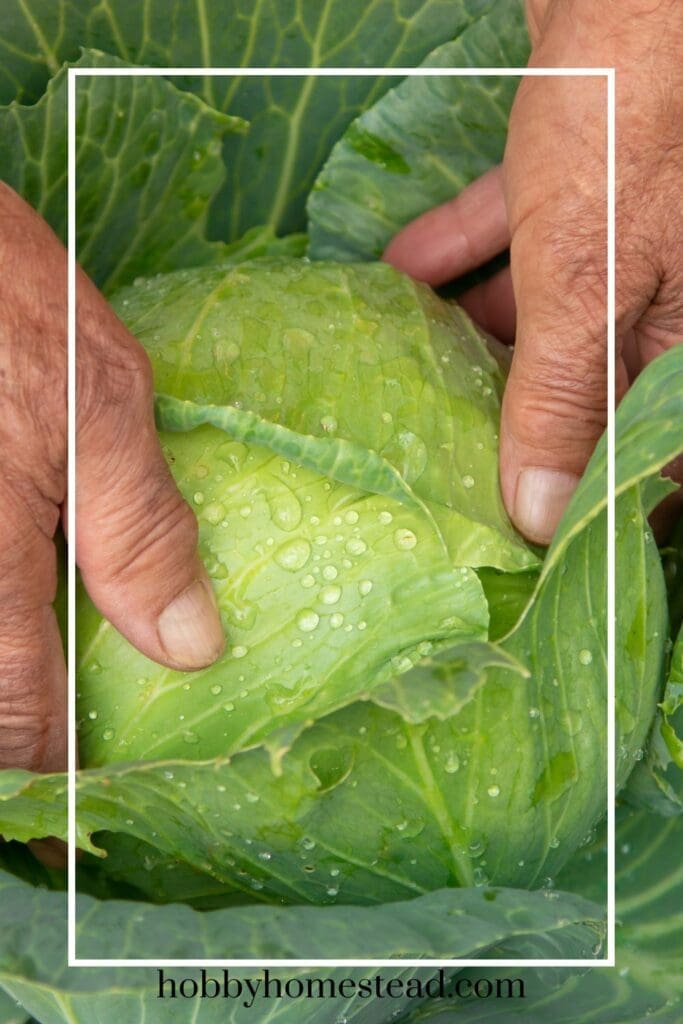We’ll show you how to harvest cabbage, so it keeps producing, the care it needs after cutting, and what to expect from your second harvest. Did you know there is a way to regrow cabbage?
Many gardeners pull their cabbage plant from the ground after harvesting the main head. But if you’re looking to get more from your garden, there’s a smarter way to harvest.
With the right technique, you can encourage your cabbage to produce a second round of smaller, tender heads. Essentially giving you more yield from the same plant.

🌱 Can Cabbage Regrow After Harvest?
Yes! Cabbage is a cool-season biennial, and while it’s usually grown as an annual, it can regrow after the main head is cut. If the base of the plant is left intact. This regrowth produces secondary heads, which are smaller but still perfectly edible and great for fresh eating or cooking.
While not all varieties regrow with the same enthusiasm, green cabbage and some red varieties tend to do well with this method. Savoy and Napa can regrow too, though they’re less consistent.
Understanding How Cabbage Grows
Cabbage grows by forming a tight ball of leaves called a head, which develops from the plant’s main growing point in the center. If you cut off the whole head, you’re also removing that main growing point.
So the plant can’t grow anymore. But if you just pick a few outer leaves at a time, the cabbage can keep growing. It will start producing new leaves from the sides, giving you more to harvest later on.

Picking Outer Cabbage Leaves for Ongoing Harvest
One of the easiest and most effective ways to keep your cabbage plants growing strong is to harvest the outer leaves instead of cutting the whole head.
This method lets you enjoy fresh cabbage over a longer period without stopping the plant from producing more. It’s a great way to get the most out of your garden throughout the season.
Here’s how to do it:
How to Harvest Cabbage Using the Outer Leaf Method
- Start with a healthy plant
Make sure your cabbage plant is well-established with a good number of large outer leaves. The inner leaves should still be forming the head. - Choose mature outer leaves
Look for the outermost leaves that are large, firm, and dark green. These are the oldest and most mature leaves. Perfect for harvesting. - Use clean scissors or garden shears
Cut the selected outer leaves near the base of the stem, taking care not to damage the central part of the plant (where the new growth comes from). You can also gently snap them off by hand if you’re careful. - Leave the inner leaves and growing center untouched
The center of the cabbage (called the growing tip or apical meristem) is where new leaves form. By leaving it intact, you allow the plant to keep producing more leaves. - Harvest regularly, but not too much at once
Only take 2–4 leaves at a time, depending on the size of the plant. This gives it enough energy and foliage to keep growing strong. - Keep your plant happy
Water regularly, keep pests in check, and provide occasional fertilizer to support continued leaf growth.
How to Harvest Cabbage to Encourage Regrowth
Did you know your cabbage plant can keep on giving even after the first harvest? With a few simple steps, you can encourage it to grow small new heads for a bonus crop. Instead of pulling the whole plant, this method lets you cut it in a way that signals the cabbage to start producing again. Here’s how to harvest it the right way to give your plant a second chance.
To give your cabbage a second life, follow these steps carefully:
- Use a sharp knife or garden pruners
Make a clean, angled cut across the stem. - Cut just above the outer leaves
Leave the lower portion of the plant in the ground, including several of the large outer leaves and the central stem base. - Do not disturb the root system
Leaving the roots and some leaves intact keeps the plant stable and encourages it to redirect energy into new growth.
Within a week or two, you may see small buds forming in the leaf axils (where the leaves meet the stem). These are your future mini heads!

Post-Harvest Care for Continued Growth
To keep your cabbage plant healthy after harvest:
- Water consistently to help the plant recover
- Mulch around the base to retain moisture and suppress weeds
- Inspect for pests, especially cabbage worms or aphids, which may be more attracted to regrowing plants
- Fertilize lightly, if needed, with compost tea or a balanced organic fertilizer
🥬 What to Expect from the Second Harvest
Secondary cabbage heads won’t be as large as the first, but they’re usually tender and sweet, especially in cool weather. Most plants will produce 2 to 5 smaller heads, and you can harvest them individually as they mature.
These mini heads are perfect for sautéing, roasting, or adding fresh to slaws. They won’t store as long as full-size cabbage, so plan to use them soon after picking.
When to Call It Quits
Eventually, your cabbage plant will slow down or stop producing altogether. Signs it’s time to pull the plant and replant:
- No new heads forming after several weeks
- Yellowing or drying outer leaves
- Pest damage that’s hard to control
- Upcoming extreme weather (heat or hard frost)
At that point, pull the plant and compost it or feed it to your chickens if you have them.
What happens if I harvest cabbage too early?
If you harvest cabbage too early, you might end up with small, underdeveloped heads that are loose instead of tight and dense. These immature cabbages won’t have the full flavor or crisp texture you’re looking for, and they won’t store as well either.
Plus, once you cut the head, even a small one, the plant shifts its energy away from growth. So you miss out on the chance for it to bulk up into a fuller, more satisfying harvest. It’s best to wait until the head feels firm and solid when you squeeze it gently. If it still feels soft or loose, give it a little more time to mature in the garden.
More Cabbage, Less Work
By harvesting cabbage the right way, you can keep your garden productive longer and get more food from each plant. Leaving the base intact, providing care after the first harvest, and watching for new growth are simple steps that can lead to a bonus round of tender cabbage heads.
It’s a great method for homesteaders looking to maximize yield with minimal effort. Once you try it, you may never go back to the old way again.


